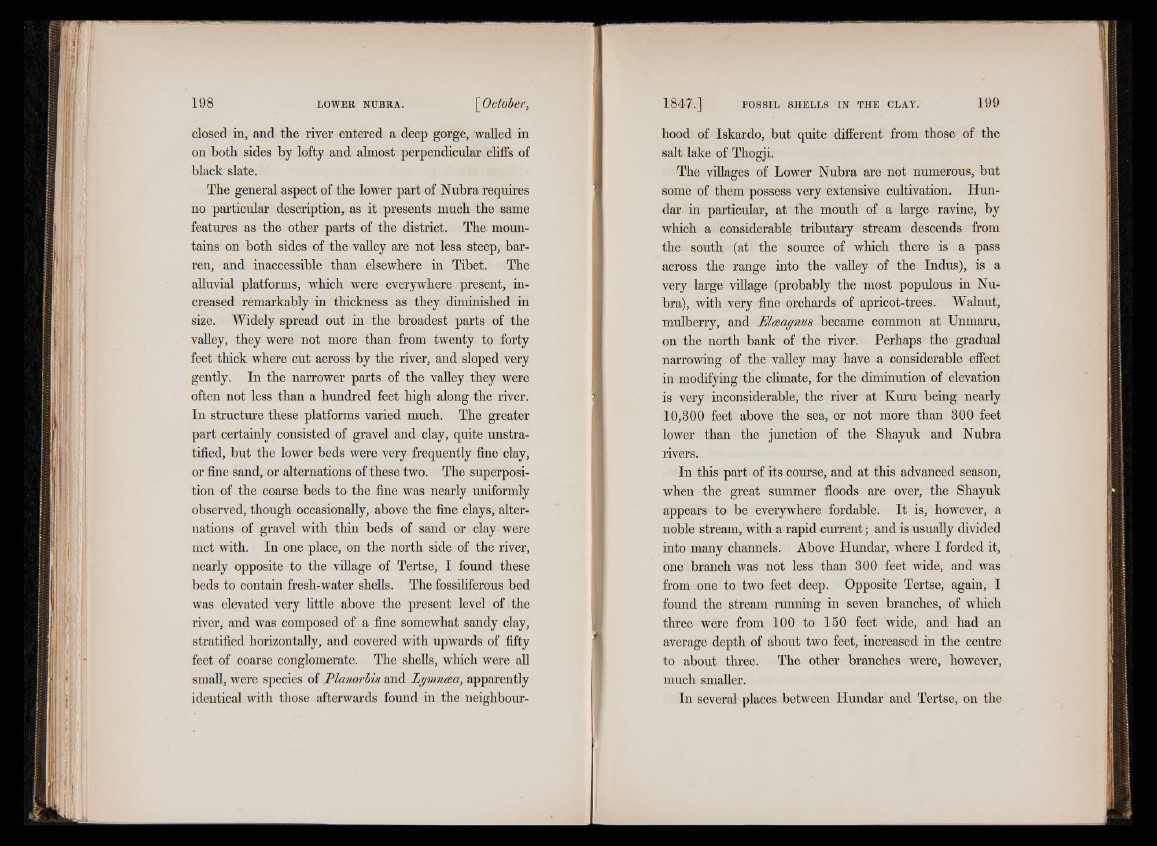
closed in, and the river entered a deep gorge, walled in
on both sides by lofty and almost perpendicular cliffs of
black slate.
The general aspect of the lower part of Nubra requires
no particular description, as it presents much the same
features as the other parts of the district. The mountains
on both sides of the valley are not less steep, barren,
and inaccessible than elsewhere in Tibet. The
alluvial platforms, which were everywhere present, increased
remarkably in thickness as they diminished in
size. Widely spread out in the broadest parts of the
valley, they were not more than from twenty to forty
feet thick where cut across by the river, and sloped very
gently. In the narrower parts of the valley they were
often not less than a hundred feet high along the river.
In structure these platforms varied much. The greater
part certainly consisted of gravel and clay, quite unstratified,
but the lower beds were very frequently fine clay,
or fine sand, or alternations of these two. The superposition
of the coarse beds to the fine was nearly uniformly
observed, though occasionally, above the fine clays, alternations
of gravel with thin beds of sand or clay were
met with. In one place, on the north side of the river,
nearly opposite to the village of Tertse, I found these
beds to contain fresh-water shells. The fossiliferous bed
was elevated very little above the present level of the
river, and was composed of a fine somewhat sandy clay,
stratified horizontally, and covered with upwards of fifty
feet of coarse conglomerate. The shells, which were all
small, were species of Planorbis and Lymncea, apparently
identical with those afterwards found in the neighbourhood
of Iskardo, but quite different from those of the
salt lake of Thogji.
The villages of Lower Nubra are not numerous, but
some of them possess very extensive cultivation. Hun-
dar in particular, at the mouth of a large ravine, by
which a considerable; tributary stream descends from
the south (at the source of which there is a pass
across the range into the valley of the Indus), is a
very large village (probably the most populous in Nubra),
with very fine orchards of apricot-trees. Walnut,
mulberry, and fflaagnus became common at Unmaru,
on the north bank of the river. Perhaps the gradual
narrowing of the valley may have a considerable effect
in modifying the climate, for the diminution of elevation
is very inconsiderable, the river at Kuru being nearly
10,300 feet above the sea, or not more than 300 feet
lower than the junction of the Shayuk and Nubra
rivers.
In this part of its course, and at this advanced season,
when the great summer floods are over, the Shayuk
appears to be everywhere fordable. It is, however, a
noble stream, with a rapid current; and is usually divided
into many channels. Above Hundar, where I forded it,
one branch was not less than 300 feet wide, and was
from one to two feet deep. Opposite Tertse, again, I
found the stream running in seven branches, of which
three were from 100 to 150 feet wide, and had an
average depth of about two feet, increased in the centre
to about three. The other branches were, however,
much smaller.
In several places between Hundar and Tertse, on the